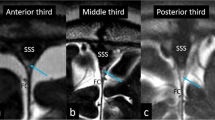Abstract
Background and purpose
The fastigium cerebelli is an important topographical landmark for neurosurgeons and radiologists. However, few studies have characterized the morphology of the fastigium cerebelli. We aimed to investigate the fastigium cerebelli using postmortem specimens and magnetic resonance imaging (MRI) in vivo.
Materials and methods
Three cadaveric brains were midsagittally sectioned for observing the fastigium cerebelli. Additionally, 66 outpatients underwent MRI, including sagittal T1-weighted imaging, axial T2-weighted imaging, and coronal constructive interference in steady-state (CISS) sequence.
Results
In the cadaveric specimens, the fastigium cerebelli was observed as a beak-like dorsal protrusion of the fourth ventricle. Its inner surface was observed as a small fovea. On serial CISS images, the fastigium cerebelli consistently possessed a pair of triangular-shaped, dorsal extensions lying parasagittally along the nodule. These extensions were classified as symmetrical, right-side dominant, or left-side dominant. The symmetrical type was the most predominant and comprised 60.6% of the extensions, while the right-side dominant and left-side dominant types comprised 13.6 and 25.8%, respectively. In 91% of the 66 patients, the number of slices covering the entirety of the dorsal extensions were the same on both sides. The fastigial angle (θ) formed by lines tangent to the superior and inferior medullary velums varied widely.
Conclusions
The fastigium cerebelli has a pair of dorsal extensions lying parasagittally along the nodule. Coronal CISS sequence is useful in delineating the fastigium cerebelli in vivo.








Similar content being viewed by others
References
Brocklehurst G (1969) The development of the human cerebrospinal fluid pathway with particular reference to the roof of the fourth ventricle. J Anat 105:467–475
Casselman JW, Kuhweide R, Deimling M, Ampe W, Dehaene I, Meeus L (1993) Constructive interference in steady state-3DFT MR imaging of the inner ear and cerebellopontine angle. AJNR Am J Neuroradiol 14:47–57
Chen X, Hou X, Gao W, Zhu M, Wang Y, Wang H, Wang X, Lin Z (2010) Morphology of the adult midsagittal brainstem in relation to the reference systems MRI-based variability study. Acad Radiol 17:708–717
Diedrichsen J, Maderwald S, Küper M, Thürling M, Rabe K, Gizewski ER, Ladd ME, Timmann D (2011) Imaging the deep cerebellar nuclei: a probabilistic atlas and normalization procedure. Neuroimage 54:1786–1794
Glickstein SB, Ilch CP, Reis DJ, Golanov EV (2001) Stimulation of the subthalamic vasodilator area and fastigial nucleus independently protects the brain against focal ischemia. Brain Res 912:47–59
Iadecola C, Underwood MD, Reis DJ (1986) Muscarinic cholinergic receptors mediate the cerebrovasodilation elicited by stimulation of the cerebellar fastigial nucleus in rat. Brain Res 368:375–379
Laborde G, Gilsbach JM, Harders A, Seeger W (1992) Experience with the infratentorial supracerebellar approach in lesions of the quadrigeminal region, posterior third ventricle, culmen cerebelli, and cerebellar peduncle. Acta Neurochir (Wien) 114:135–138
Leung V, Magnussen JS, Stoodley MA, Bilston LE (2016) Cerebellar and hindbrain motion in Chiari malformation with and without syringomyelia. J Neurosurg Spine 24:546–555
Matsushima T, Rhoton AL Jr, Lenkey C (1982) Microsurgery of the fourth ventricle: part 1. Microsurgical anatomy. Neurosurgery 11:631–667
Mussi AC, Rhoton AL Jr (2000) Telovelar approach to the fourth ventricle: microsurgical anatomy. J Neurosurg 92:812–823
Niemann K, van den Boom R, Haeselbarth K, Afshar F (1999) A brainstem stereotactic atlas in a three-dimensional magnetic resonance imaging navigation system: first experiences with atlas-to-patient registration. J Neurosurg 90:891–901
O’Rahilly R, Müller F (1990) Ventricular system and choroid plexuses of the human brain during the embryonic period proper. Am J Anat 189:285–302
Roelants JA, Koning IV, Raets MM, Willemsen SP, Lequin MH, Steegers-Theunissen RP, Reiss IK, Vermeulen MJ, Govaert P, Dudink J (2016) A New Ultrasound marker for bedside monitoring of preterm brain growth. AJNR Am J Neuroradiol 37:1516–1522
Salma A, Yeremeyeva E, Baidya NB, Sayers MP, Ammirati M (2013) An endoscopic, cadaveric analysis of the roof of the fourth ventricle. J Clin Neurosci 20:710–714
Tepper R, Kidron D, Hershkovitz R (2009) Sonographic measurements of the fetal fastigium between 20 and 40 weeks’ gestation. J Ultrasound Med 28:1657–1661
Tubbs RS, Bosmia AN, Loukas M, Hattab EM, Cohen-Gadol AA (2013) The inferior medullary velum: anatomical study and neurosurgical relevance. J Neurosurg 118:315–318
Acknowledgements
This study did not receive any grant funding.
Author information
Authors and Affiliations
Contributions
ST and JCF-M developed the project of study. JCF-M performed cadaver dissection and collected anatomical data. HI and YY collected the imaging data. HO and HI analyzed the imaging data. ST wrote the manuscript.
Corresponding author
Ethics declarations
Conflict of interest
The authors have no conflicts of interest to declare regarding the materials or methods in this study or the findings specified in this paper.
Rights and permissions
About this article
Cite this article
Tsutsumi, S., Fernandez-Miranda, J.C., Ishii, H. et al. Dorsal extensions of the fastigium cerebelli: an anatomical study using magnetic resonance imaging. Surg Radiol Anat 40, 829–834 (2018). https://doi.org/10.1007/s00276-018-2023-3
Received:
Accepted:
Published:
Issue Date:
DOI: https://doi.org/10.1007/s00276-018-2023-3




